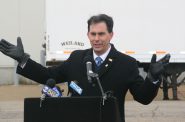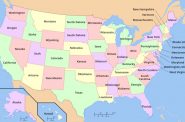Did Act 10 Improve Wisconsin’s Economy?
Scott Walker fell far short of his promises and behind some neighboring states.

Photo by Richard Hurd. (CC BY 2.0)
The recent circuit court decision that Act 10 violates the Wisconsin Constitution invites a reconsideration of whether that law benefited Wisconsin as it was intended or at least promoted to do.
In his successful campaign for Wisconsin governor, Scott Walker promised that, if elected, Wisconsin would create 250,00 new private sector jobs by the end of his first term in office. One of the beliefs apparently underlying the actions of the Walker administration was that unions, particularly unions representing government employees, had grown too powerful and were holding back the state’s economy.
Act 10 was followed four years later by a right-to-work law aimed at weakening unions in the private sector.
Act 10 stripped collective bargaining rights from general employees and limited employees’ ability to bargain solely to wage increases. Under the act, wage increases could not exceed inflation.
The law also included a number of provisions aimed at making life more difficult for public employee unions. For example, these unions were required to hold annual recertification elections. To win recertification elections, the unions were required to have a majority of all members, not just those voting in the election. In addition, Act 10 shifted some retirement and benefit costs from employers to employees, effectively cutting compensation.
For some employees in public safety jobs the story was very different. Act 10 exempted some of these and their unions from these restrictions. In a recent decision, Dane County Circuit Court Judge Jacob Frost ruled that Act 10 violates the Wisconsin Constitution because it lacked any rationale behind deciding which positions qualified a person as a “public safety employee.”
As a result, in Abbotsford Education Association et al vs. Wisconsin Employment Relations Commission et al, Judge Frost declared that the parts of Act 10 that created the public safety employee exemption are unconstitutional.
The graph below plots the number of new private sector Wisconsin jobs during Walker’s two terms as governor, between the start of 2011, when the nation was recovering from the recession of 2008, and the end of 2018. By the beginning of Walker’s second term, around 192,000 new jobs had been created, slightly more than half Walker’s promise.
If Wisconsin’s job growth fell well below Walker’s promised number, did it still exceed job growth in neighboring states that don’t have the same restrictions on employee unionizing? The next graph compares job growth in Wisconsin compared to the three states that touch both Wisconsin and the Great Lakes. Wisconsin jobs are shown in green, Minnesota’s in red, Michigan’s in yellow, and Illinois’ in blue.
To eliminate the differences in the starting number jobs of the four states, I set the starting jobs at January 2011 at 100.
It is worth noting that factors other than the lack of an Act 10 equivalent may have contributed to the differences between state results. For example, Michigan and its auto industry was particularly hit by the Great Recession of 2008. Thus, it may have been particularly benefited by the recovery from that recession.
Conversely, Illinois’ job growth may have been negatively affected by its internal conflicts. On November 4, 2014, Republican Bruce Rauner was elected Governor of Illinois with widespread support. He carried every county in the state except for Cook, home to the city of Chicago.
That widespread initial support soon disappeared as Rauner battled the state legislature over how to fix the state budget over his insistence that the budget should be balanced by massive layoffs and cuts to state programs. As a result, Rauner was defeated in the 2018 election.
The next graph shows the same four states’ growth in real gross domestic product (GDP). “Real” means growth is adjusted to eliminate the effect of inflation. Minnesota’s GDP growth takes the lead among the four states, followed by Michigan. Perhaps reflecting the battle between Illinois’ governor and its legislature, described earlier, Illinois fell below Wisconsin’s growth.
Finally, the next graph plots the path of the average wage in the four states. Michigan is consistently at the bottom, perhaps reflecting that troubles in the auto industry left many of its former workers accepting jobs in industries that paid more poorly.
The data suggest that, at best, the policies pushed by the Scott Walker administration, including Act 10, failed to lead to better economic outcomes in job growth, GDP growth and pay.
At worst, they may point to a conclusion that this approach hurt the state’s economy. Despite the lack of evidence in support of these policies, they will likely continue to be the go-to policies of many on the right.
If you think stories like this are important, become a member of Urban Milwaukee and help support real, independent journalism. Plus you get some cool added benefits.
More about the ACT 10
- Susan Crawford Attempted to Overturn Act 10 - Brad Schimel - Feb 26th, 2025
- Despite Act 10, Union Argues UW Health Nurses Can Collectively Bargain - Rich Kremer - Feb 13th, 2025
- Protasiewicz Says She Won’t Recuse From Act 10 Case - Anya van Wagtendonk - Feb 13th, 2025
- Unions: We Remain Confident in Merits of Our Case - Wisconsin Education Association Council - Feb 12th, 2025
- Supreme Court Justice Brian Hagedorn Recuses Himself From Act 10 Challenge - Rich Kremer - Jan 31st, 2025
- Republicans Push Justice Protasiewicz to Recuse From Act 10 Case - Anya van Wagtendonk - Jan 29th, 2025
- Ruling That Struck Down Act 10 Put on Hold - Rich Kremer - Dec 20th, 2024
- Data Wonk: Did Act 10 Improve Wisconsin’s Economy? - Bruce Thompson - Dec 12th, 2024
- Op Ed: Republicans Behind the Times on Act 10 - Ruth Conniff - Dec 11th, 2024
- Murphy’s Law: Act 10 Ruling Could Be Tough to Overturn - Bruce Murphy - Dec 9th, 2024
Read more about ACT 10 here
Data Wonk
-
Life Expectancy in Wisconsin vs. Other States
 Dec 10th, 2025 by Bruce Thompson
Dec 10th, 2025 by Bruce Thompson
-
How Republicans Opened the Door To Redistricting
 Nov 26th, 2025 by Bruce Thompson
Nov 26th, 2025 by Bruce Thompson
-
The Connection Between Life Expectancy, Poverty and Partisanship
 Nov 21st, 2025 by Bruce Thompson
Nov 21st, 2025 by Bruce Thompson






















So giving government more money to do less work like a collapsing Illinois is the solution Bruce?
What a ridiculous question, Cotic. Where in Bruce’s analysis does he in anyway extoll Illinois’ economic strength. The state that appears to have done the best job of navigating the recession recovery is Minnesota. Minnesota raised the tax rate on the wealthiest by 2 percentage points. That influx of revenue made it possible for the state to invest in initiatives that spurred economic recovery. Minnesota government used the influx of money to accelerate the economy and was much more successful than states’–like Wisconsin and Illinois–ideological approach.
I just moved here from NJ, so I don’t have adequate background on all this. Except that Trump won in WI b/c so many people are unhappy with the status quo and the price of groceries, etc.
Accordingly, is it possible to increase the tax rate on the wealthiest in Wisconsin as Minnesota did?
Data Wonk is great, as always!!!